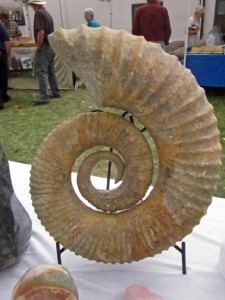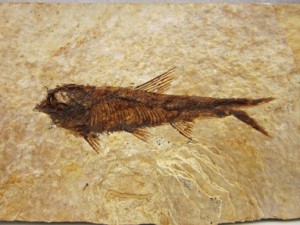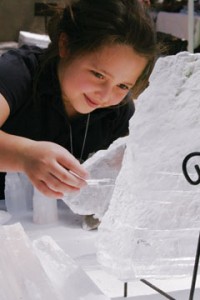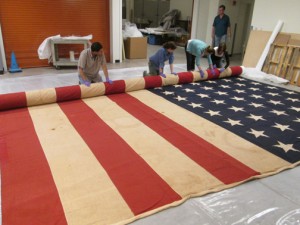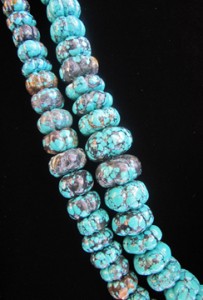 Formed as water flows around rocks in sunny, desert lands, turquoise has come to symbolize both water and sky. From Cerrillos to China to the Middle East, the people who found it, mined it, polished it and wore it believed it empowered them with the promise of safety, health and plenty.
Formed as water flows around rocks in sunny, desert lands, turquoise has come to symbolize both water and sky. From Cerrillos to China to the Middle East, the people who found it, mined it, polished it and wore it believed it empowered them with the promise of safety, health and plenty.
The lore of turquoise helps open the 8th Annual Palace Gem & Mineral Show, Sept. 27-29, in the Palace Courtyard. Join Museum of Indian Arts & Culture Curator Maxine McBrinn for a kickoff lecture on Friday, Sept. 27, at 6 pm, in the museum auditorium. “Turquoise, Water, Sky” focuses on the history of turquoise in the Southwest and its evolution as jewelry from prehistoric times to today. Even turquoise’s name spans several international time zones. French admirers dubbed it with their word for turkey stone, “because they believed the beautiful blue stones came from Turkey,” McBrinn said. (In fact, they came from Persia.)
McBrinn’s lecture offers tantalizing hints to an exhibition of the same name opening this spring at the Museum of Indian Arts & Culture. Admission to the event is $5 at the door, and seating is limited. Cash or check only, please.
Friday through Sunday, the shady Palace Courtyard will play host to a variety of exhibitors offering geodes, fossils, opals, turquoise and more for sale. Entry is free through the Blue Gate south of the History Museum’s main entrance on Lincoln Avenue.
Some of the most knowledgeable miners and collectors in the Southwest will share important tips in casual al fresco lectures. Jewelry-making workshops will be offered each day for $20.
The schedule:
9 am to 5:30 pm: Palace Gem & Mineral Show open in the Palace Courtyard.
6 pm: “Turquoise, Water, Sky.” Maxine McBrinn, curator of archaeology at the New Mexico Museum of Indian Arts & Culture, speaks in the History Museum Auditorium. $5 at the door.
McBrinn is currently developing Turquoise, Water, Sky, a spring 2014 exhibit about turquoise in the Southwest for the Museum of Indian Arts & Culture. She has conducted archaeological field work in Colorado, Wyoming, and Texas, but primarily in New Mexico. She is the author, with Linda Cordell, of Archaeology in the Southwest, Third Edition (2012, Left Coast Press).
Saturday, September 28
9 am to 4 pm: Palace Gem & Mineral Show open in the Palace Courtyard.
10 am: Opal cutting and polishing demonstration by Sandy Craig. The owner of Orca Gems & Opals in Littleton, Colo., has been cutting and polishing the gems for over 20 years, along the way developing special methods for getting the most out of a given piece of rough opal. See how he turns what looks like a forgettable stone into a glittering jewel.
11:30 pm: “History of Fakery in Gemstones: Questions You Should Ask Before Buying,” by Garrick Beck. The owner of Natural Stones in Santa Fe will give a talk about the history of pulling the wool over consumers’ eyes with stones that have been dyed, synthesized, stabilized and enhanced, and teaches you four things to ask before buying gemstones.
1 pm: “Copper Mining in New Mexico,” by Gregory Jaekel. The co-owner of Star Mountain Trading Company in Silver City talks about the history of copper mines and their byproducts, turquoise.
2 pm: Jewelry-making workshop with April Redbird. Learn the art of gem and wire wrapping to create your own pair of earrings from the co-owner of Star Mountain Trading Company. Reserve a space by calling 505-476-5156. Class fee of $20 payable at the event, cash or check only. (Please make checks payable to the Museum of New Mexico Foundation.)
9 am to 4 pm: Palace Gem & Mineral Show open in the Palace Courtyard.
10 am: Opal cutting and polishing demonstration by Sandy Craig. The owner of Orca Gems & Opals in Littleton, Colo., has been cutting and polishing the gems for over 20 years, along the way developing special methods for getting the most out of a given piece of rough opal. See how he turns what looks like a forgettable stone into a glittering jewel.
Noon: “History of Fakery in Gemstones: Questions You Should Ask Before Buying,” by Garrick Beck. The owner of Natural Stones in Santa Fe will give a talk about the history of pulling the wool over consumers’ eyes with stones that have been dyed, synthesized, stabilized and enhanced, and teaches you four things to ask before buying gemstones.
2 pm: Jewelry-making workshop with April Redbird. Learn the art of gem and wire wrapping to create your own pair of earrings from the co-owner of Star Mountain Trading Company. Reserve a space by calling 505-476-5156. Class fee of $20 payable at the event, cash or check only. (Please make checks payable to the Museum of New Mexico Foundation.)
Garrick Beck, Natural Stones, Santa Fe
Philip and Eleanor Bové, Roadrunner Mining and Minerals, Santa Fe
Sandy Craig, Orca Gems & Opals, Littleton, Colorado
April Redbird and Gregory Jaekel, Star Mountain Trading Co., Silver City
Richard Kocurek, Bright Star Gemstones, Crested Butte, Colorado
John Scully, Scully’s Minerals, Fairview, New Mexico
Greg and Carolyn Tunnicliff, Phantom, Colorado
Rosoarinoro Marie Bernadette, Madagascar Import Seam Inc., Tucson
Rory Palmore, Silver Stone, Gallup
Mike Pierce and Jayne Aubele, New Mexico Museum of Natural History and Science, Albuquerque

